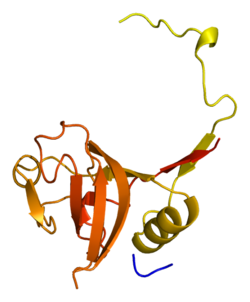組織蛋白酶L1(英語:Cathepsin L1)是人類體內由CTSL1基因編碼的蛋白質。[3][4][5]該蛋白質是木瓜樣蛋白酶,是一種溶體半胱胺酸蛋白酶,在細胞內蛋白質分解代謝中起著主要的作用。[6][7][8][9]
Quick Facts 組織蛋白酶L1, 已知的結構 ...
Close
組織蛋白酶L1是肽酶C1(組織蛋白酶)MEROPS家族的成員。組織蛋白酶L1在包括正常溶體介導的蛋白質周轉、抗原、前蛋白加工以及細胞凋亡在內的多種過程中發揮重要的作用。[10]其受質包括膠原蛋白、彈性蛋白和SERPINA1,這是嗜中性球彈性蛋白酶活性的主要控制元素。組織蛋白酶L1與多種病理過程有關,包括肌病、冠狀動脈疾病中的肌原纖維壞死以及腎小管對蛋白尿的反應。它是由二硫鍵連接的重鏈和輕鏈組成的二聚體,均由單一蛋白質前體產生。已發現該基因至少有兩種編碼相同蛋白質的轉錄變體。[5]
病毒進入細胞需要2型新冠病毒S2棘蛋白的裂解。此過程可以通過位於細胞膜上的蛋白酶——跨膜絲胺酸蛋白酶2或內溶體中的組織蛋白酶(主要是組織蛋白酶L1)來完成。[11]羥氯喹可以抑制內溶體中組織蛋白酶L1的作用,但由於與跨膜絲胺酸蛋白酶2裂解相比,組織蛋白酶L1的裂解較小,因此羥氯喹對2型新冠病毒感染的抑制作用很小。[11]
雖然組織蛋白酶L1通常被表徵為溶體蛋白酶,但它可以被分泌,導致病理性炎症。[12]組織蛋白酶L1和其他木瓜樣蛋白酶在引起病理性炎症時往往由巨噬細胞和其他侵入組織的免疫細胞分泌而出。[13]
組織蛋白酶L1已被證明與胱抑素A有相互作用。[14][15]
組織蛋白酶L1已在許多生物體中發現,包括魚類[16]、鳥類、哺乳動物和海綿。[17]
Chauhan SS, Popescu NC, Ray D, Fleischmann R, Gottesman MM, Troen BR. Cloning, genomic organization, and chromosomal localization of human cathepsin L. J Biol Chem. Feb 1993, 268 (2): 1039–45. PMID 8419312. doi:10.1016/S0021-9258(18)54038-2  .
. Barrett AJ, Buttle DJ, Mason RW. Lysosomal cysteine proteinases. ISI Atlas of Science. Biochemistry. 1988, 1: 256–260.
Dickinson DP. Cysteine Peptidases of Mammals: Their Biological Roles and Potential Effects in the Oral Cavity and Other Tissues in Health and Disease. Critical Reviews in Oral Biology and Medicine. 2002, 13 (3): 238–75. PMID 12090464. doi:10.1177/154411130201300304. Estrada, S; Nycander M; Hill N J; Craven C J; Waltho J P; Björk I. The role of Gly-4 of human cystatin A (stefin A) in the binding of target proteinases. Characterization by kinetic and equilibrium methods of the interactions of cystatin A Gly-4 mutants with papain, cathepsin B, and cathepsin L. Biochemistry. May 1998, 37 (20): 7551–60. ISSN 0006-2960. PMID 9585570. doi:10.1021/bi980026r. Venkatesh K, Prasanth B, Rajesh P, Annie JG, Mukesh P, Jesu A. A murrel cysteine protease, cathepsin L: bioinformatics characterization, gene expression and proteolytic activity. Biologia. 2014, 39 (3): 395–406. doi:10.2478/s11756-013-0326-8  .
.
- Smith CG, Smith MT, Besch NF, et al. Effect of delta 9-tetrahydrocannabinol (THC) on female reproductive function.. Advances in the Biosciences. 1980, 22–23: 449–67. ISBN 9780080237596. PMID 116880. doi:10.1016/b978-0-08-023759-6.50040-8.
- Goretzki L, Schmitt M, Mann K, et al. Effective activation of the proenzyme form of the urokinase-type plasminogen activator (pro-uPA) by the cysteine protease cathepsin L.. FEBS Lett. 1992, 297 (1–2): 112–8. PMID 1551416. S2CID 45421148. doi:10.1016/0014-5793(92)80339-I.
- Dunn AD, Crutchfield HE, Dunn JT. Thyroglobulin processing by thyroidal proteases. Major sites of cleavage by cathepsins B, D, and L.. J. Biol. Chem. 1991, 266 (30): 20198–204. PMID 1939080. doi:10.1016/S0021-9258(18)54909-7
 .
.
- Stearns NA, Dong JM, Pan JX, et al. Comparison of cathepsin L synthesized by normal and transformed cells at the gene, message, protein, and oligosaccharide levels.. Arch. Biochem. Biophys. 1991, 283 (2): 447–57. PMID 2275556. doi:10.1016/0003-9861(90)90666-M.
- Ritonja A, Popović T, Kotnik M, et al. Amino acid sequences of the human kidney cathepsins H and L.. FEBS Lett. 1988, 228 (2): 341–5. PMID 3342889. S2CID 45768546. doi:10.1016/0014-5793(88)80028-0
 .
.
- Gal S, Gottesman MM. Isolation and sequence of a cDNA for human pro-(cathepsin L).. Biochem. J. 1988, 253 (1): 303–6. PMC 1149292
 . PMID 3421948. doi:10.1042/bj2530303.
. PMID 3421948. doi:10.1042/bj2530303.
- Johnson DA, Barrett AJ, Mason RW. Cathepsin L inactivates alpha 1-proteinase inhibitor by cleavage in the reactive site region.. J. Biol. Chem. 1986, 261 (31): 14748–51. PMID 3490478. doi:10.1016/S0021-9258(18)66935-2
 .
.
- Mason RW, Walker JE, Northrop FD. The N-terminal amino acid sequences of the heavy and light chains of human cathepsin L. Relationship to a cDNA clone for a major cysteine proteinase from a mouse macrophage cell line.. Biochem. J. 1987, 240 (2): 373–7. PMC 1147428
 . PMID 3545185. doi:10.1042/bj2400373.
. PMID 3545185. doi:10.1042/bj2400373.
- Joseph L, Lapid S, Sukhatme V. The major ras induced protein in NIH3T3 cells is cathepsin L.. Nucleic Acids Res. 1987, 15 (7): 3186. PMC 340927
 . PMID 3550705. doi:10.1093/nar/15.7.3186.
. PMID 3550705. doi:10.1093/nar/15.7.3186.
- Kärgel HJ, Dettmer R, Etzold G, et al. Action of rat liver cathepsin L on glucagon.. Acta Biol. Med. Ger. 1982, 40 (9): 1139–43. PMID 7340337.
- Bevec T, Stoka V, Pungercic G, et al. Major histocompatibility complex class II-associated p41 invariant chain fragment is a strong inhibitor of lysosomal cathepsin L.. J. Exp. Med. 1996, 183 (4): 1331–8. PMC 2192513
 . PMID 8666891. doi:10.1084/jem.183.4.1331.
. PMID 8666891. doi:10.1084/jem.183.4.1331.
- Coulombe R, Grochulski P, Sivaraman J, et al. Structure of human procathepsin L reveals the molecular basis of inhibition by the prosegment.. EMBO J. 1996, 15 (20): 5492–503. PMC 452294
 . PMID 8896443. doi:10.1002/j.1460-2075.1996.tb00934.x.
. PMID 8896443. doi:10.1002/j.1460-2075.1996.tb00934.x.
- Baumgrass R, Williamson MK, Price PA. Identification of peptide fragments generated by digestion of bovine and human osteocalcin with the lysosomal proteinases cathepsin B, D, L, H, and S.. J. Bone Miner. Res. 1997, 12 (3): 447–55. PMID 9076588. S2CID 20815411. doi:10.1359/jbmr.1997.12.3.447
 .
.
- Fujishima A, Imai Y, Nomura T, et al. The crystal structure of human cathepsin L complexed with E-64.. FEBS Lett. 1997, 407 (1): 47–50. PMID 9141479. S2CID 46288832. doi:10.1016/S0014-5793(97)00216-0
 .
.
- Ménard R, Carmona E, Takebe S, et al. Autocatalytic processing of recombinant human procathepsin L. Contribution of both intermolecular and unimolecular events in the processing of procathepsin L in vitro.. J. Biol. Chem. 1998, 273 (8): 4478–84. PMID 9468501. doi:10.1074/jbc.273.8.4478
 .
.
- Schick C, Pemberton PA, Shi GP, et al. Cross-class inhibition of the cysteine proteinases cathepsins K, L, and S by the serpin squamous cell carcinoma antigen 1: a kinetic analysis.. Biochemistry. 1998, 37 (15): 5258–66. PMID 9548757. doi:10.1021/bi972521d.
- Estrada S, Nycander M, Hill NJ, et al. The role of Gly-4 of human cystatin A (stefin A) in the binding of target proteinases. Characterization by kinetic and equilibrium methods of the interactions of cystatin A Gly-4 mutants with papain, cathepsin B, and cathepsin L.. Biochemistry. 1998, 37 (20): 7551–60. PMID 9585570. doi:10.1021/bi980026r.
- Halfon S, Ford J, Foster J, et al. Leukocystatin, a new Class II cystatin expressed selectively by hematopoietic cells.. J. Biol. Chem. 1998, 273 (26): 16400–8. PMID 9632704. doi:10.1074/jbc.273.26.16400
 .
.




